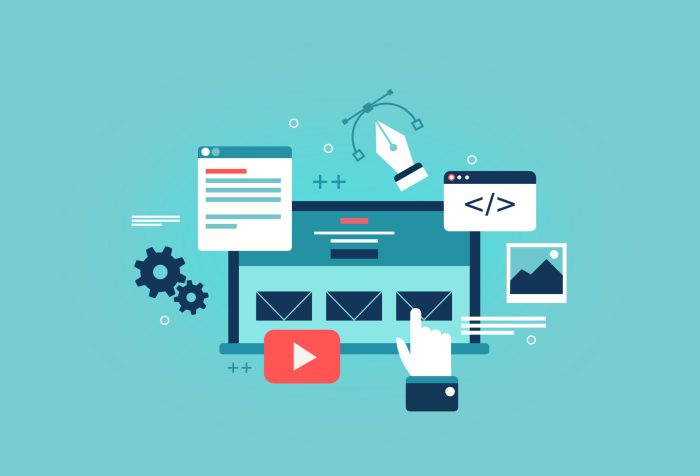Designing Interactive Content introduces a whole new dimension to digital experiences, showcasing the power of engagement through interactive elements like quizzes, games, and surveys. Get ready to dive into a world where creativity meets user interaction in the most captivating ways.
From exploring the concept of interactive content to understanding user experience and the various types of interactive elements, this topic is sure to spark your creativity and elevate your design skills.
Overview of Designing Interactive Content
Interactive content refers to digital content that requires active participation from users, allowing them to engage and interact with the material. This type of content goes beyond passive consumption and encourages users to make choices, answer questions, or explore different paths within the content itself.
Examples of Interactive Content
- Quizzes: Interactive quizzes allow users to test their knowledge on a particular topic and receive immediate feedback on their answers.
- Games: Interactive games entertain users while also challenging them to think strategically or solve puzzles.
- Surveys: Interactive surveys engage users by allowing them to provide feedback or opinions on specific questions or topics.
Benefits of Using Interactive Content
- Increased Engagement: Interactive content captivates users and keeps them actively involved, leading to higher levels of engagement.
- Enhanced User Experience: By providing interactive elements, users have a more personalized and enjoyable experience while consuming the content.
- Improved Learning: Interactive content promotes active learning, helping users retain information better compared to passive methods.
- Data Collection: Interactive content can gather valuable data and insights on user preferences, behaviors, and interests.
Understanding User Experience (UX) in Interactive Design

User Experience (UX) in interactive design refers to how users feel when they interact with a website, app, or any digital product. It focuses on ensuring that users have a seamless, enjoyable, and efficient experience. UX is crucial in designing interactive content because it directly impacts how users perceive and engage with the product.
Interactive elements play a significant role in enhancing UX by providing users with engaging and meaningful interactions. Features like clickable buttons, animations, sliders, and feedback mechanisms make the user experience more dynamic and intuitive. These elements not only make the content more visually appealing but also help users navigate through the interface with ease.
When creating interactive designs, it is essential to follow best practices to ensure a user-friendly experience. Some key practices include:
Best Practices for Creating Intuitive and User-Friendly Interactive Designs
- Keep the design simple and clutter-free to avoid overwhelming users.
- Use consistent design elements and navigation patterns throughout the interface.
- Provide clear and concise instructions to guide users on how to interact with the content.
- Ensure that interactive elements are responsive and work seamlessly across different devices and screen sizes.
- Incorporate user feedback mechanisms to gather insights and improve the overall user experience.
Types of Interactive Content
Interactive content comes in various forms, each serving a unique purpose in engaging and educating users effectively.
Calculators, Designing Interactive Content
- Calculators are interactive tools that allow users to input data and receive calculated results instantly.
- They can be used to engage users by providing personalized outcomes based on their inputs, such as mortgage calculators or calorie counters.
- Calculators can educate users by helping them understand complex calculations in a user-friendly manner, promoting learning through practical application.
Timelines
- Timelines are interactive visual representations of chronological events or processes.
- They engage users by presenting information in a dynamic and organized format, making it easy to follow the sequence of events.
- Timelines can educate users by illustrating historical timelines, project milestones, or product development stages effectively.
Maps
- Interactive maps allow users to explore and interact with geographical data in a dynamic way.
- They engage users by providing a hands-on experience in navigating locations, finding directions, or discovering points of interest.
- Maps can educate users by visualizing data spatially, such as population distribution, natural disaster hotspots, or historical landmarks.
Tools and Software for Designing Interactive Content

When it comes to creating interactive content, having the right tools and software can make all the difference in the final product. Let’s take a look at some popular options and compare their features to help you choose the best one for your project.
Adobe Animate
Adobe Animate is a versatile tool that allows you to create interactive animations and multimedia content. It offers a wide range of features such as timeline-based animation, interactivity with JavaScript, and export options for web and mobile platforms.
Unity
Unity is a powerful game development platform that can also be used to create interactive content beyond gaming. It provides a user-friendly interface, support for 2D and 3D content, and a vast library of assets and plugins to enhance your projects.
HTML5 and CSS3
For those who prefer coding from scratch, HTML5 and CSS3 are essential tools for designing interactive content. They offer flexibility, customization options, and compatibility with modern web browsers, making them ideal for web-based projects.
Sketch
Sketch is a popular design tool that focuses on user interface and user experience design. It offers a range of features for creating interactive prototypes, wireframes, and mockups, making it a great choice for designers looking to test their ideas before development.
Considerations for Choosing the Right Tool
When selecting a tool for designing interactive content, consider factors such as the project requirements, your familiarity with the tool, and the learning curve involved. It’s important to choose a tool that aligns with your project goals and allows you to bring your creative vision to life effectively.
